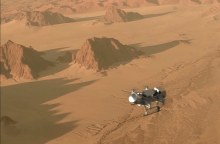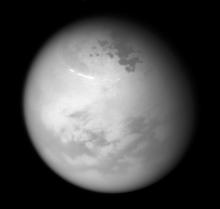Listen to today's episode of StarDate on the web the same day it airs in high-quality streaming audio without any extra ads or announcements. Choose a $8 one-month pass, or listen every day for a year for just $30.
You are here
Moon and Saturn
If you want to escape the summer heat by plunging into a cool lake or sea, there are only two places in the solar system to do so: Earth, and Titan, the largest moon of Saturn. The big difference is what’s filling those features. On Earth, it’s water. But on Titan, it’s liquid methane and ethane — hydrocarbons that are chilled to hundreds of degrees below zero.
Titan is about half again the size of Earth’s moon. It has a thick atmosphere that’s topped by smog — an orange haze of hydrocarbons. Methane and ethane clouds drift through the sky, sometimes pouring rain on the surface. That fills lakes and seas, and appears to carve riverbeds.
Some of the smaller lakes are surrounded by tall cliffs. Those may have formed at a time when Titan was even colder — so cold that liquid nitrogen flowed across the surface.
A study last year said that some of the nitrogen could have trickled below the surface, forming underground pools. When Titan warmed up, the nitrogen turned to gas. It expanded, blowing sharp-rimmed holes in the surface. The holes later filled with methane and ethane, forming new lakes — perfect places for a really cool plunge.
Saturn is easy to find tonight. The planet looks like a bright star. It’s to the upper right of the Moon as night falls, and leads the Moon across the sky later on. Through a telescope, Titan looks like a tiny star near the planet. The even brighter planet Jupiter is to the right of Saturn.






